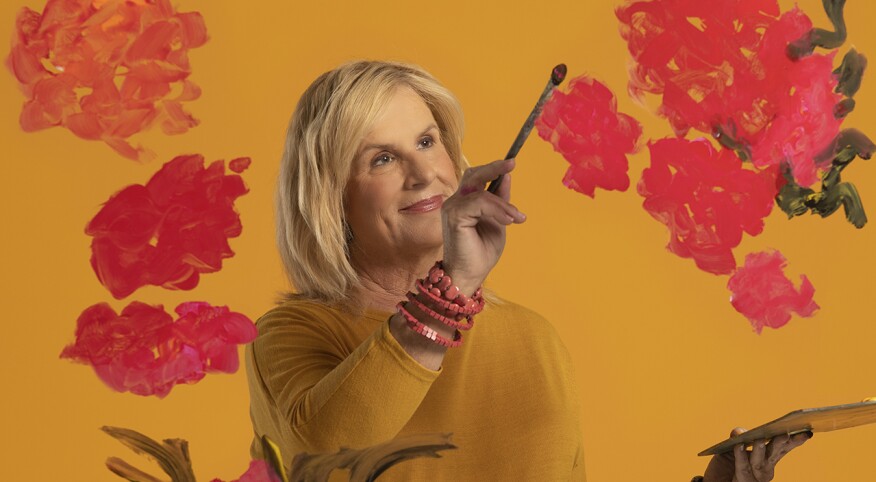If making art is the opposite of making trouble, then joy-seeking older women can consider finding stress relief by creating art in any form they wish.
From writing, drawing, knitting and painting to throwing pottery, sketching, playwriting and striking up the music, more older women see their artistic forays as anti-burnout self-love. Many, like myself, see these creative expressions as necessary additions to their lives and ways to stay mindfully present and positive.
In addition to my daily work as a journalist, author and writing coach to pay the mortgage, insurance and occasional splurges on shoes, I write, paint and sketch weekly and do live storytelling for respite and fun. These endeavors are de-stressing detours from the ongoing demands of life, work and family.
This is not just a nice idea of something quaint to do in your spare time. Creating art is a well-researched and proven way to augment well-being. And who doesn’t need that?
“Learning self-love is a leap of faith, to say the least,” writes Jenna Banks in her 2022 book, I Love Me More: How to Find Happiness and Success Through Self-Love. Among other strategies, Banks suggests writing as a path to creative expression — something I fully endorse and advocate.
I definitely know this to be true. In my book Writing to Save Your Life: How to Honor Your Story, I wrote: “I am suggesting that by writing you can begin to heal, whether that healing manifests itself in reduced physical symptoms or simply a shift in attitude. You may only feel lighter, calmer, or happier as a result. It may be small. It may be everything.”
Others agree.
“For me, when I sit down to write or prepare for a show, it takes me out of myself, puts me into a completely different brain zone,” says Arlene Malinowski, 65, a resident playwright with Chicago Dramatists who has written and performed plays about dealing with depression. “I think during the time I have been depressed and stressed over being depressed, writing helps me feel productive and lights up my brain in different ways,” she adds.
A 2021 Turkish study from Ordu University finds that narrative therapy, expressive art and art therapy contribute to a person’s sense of well-being.
“Being involved in expressive arts enables clients to discover their deepest and usually secret feelings, to use symbols in order to represent their inner feelings and conflicts, and to express their inner problems physically,” the study’s research demonstrates.
Many see creative expression as an emotional outlet — sometimes for anger, exuberance, joy, frustration — resulting in the production of original music, prose, poetry, visual arts, textiles or performance.
The past two-plus years of the COVID-19 pandemic — resulting in immeasurable amounts of stress, burnout and frustration — may contribute to a person’s need to create art.
Textile and mixed-media artist Pamela Penney, 60, says creating art is a natural drive for her and her adult students, and that stress can be the impetus: “As an art instructor for most of my life, I strive to give people the process, tools and techniques to work through stress.”
A Chicago-area artist who works with paint, fiber, felt, sculpture, yarn and textiles, Penney says she began knitting at the age of 5, growing up in Michigan. “When I am in the creation process, it is cathartic,” she says. “I think through these last few years, I’ve tended to enjoy hibernating. The period of shutdown was a gift. I can say no to all other obligations and hang out in my studio.”
In 2021, the University of Michigan “National Poll on Healthy Aging” found among adults ages 50 to 80 that 18 percent of those surveyed said their mental health was worse than before the pandemic, with more women ages 50 to 64 with higher education reporting it was worse than other groups. “Worse sleep, depression, and anxiety during the pandemic were also more common among women than men,” the study shows.
As Penney attests, making art — in many different forms — results in stress reduction, according to research across the globe. A 2021 United Healthcare report cites that several studies found art-making is effective as self-care to reduce stress, anxiety and depression.
And if you are like me and have given — and received — mandala coloring books to friends for fun, know that you are giving them a helpful tool for mindfulness. Any adult who has colored in one of these books can attest that the simple act of creating mandalas can reduce anxiety and improve moods.
Perhaps this is why the arts-and-crafts market globally will have grown from a $35 billion industry in 2017 to a projection of $50.9 billion by 2024. Notice the burgeoning crowds in arts-and-crafts stores that point to the growing popularity of creating with paints, sketchbooks, beads, jewelry, yarn, fabrics and needlework.
Of course, creating art is not a panacea for the world’s troubles — or even your own. And putting pressure on yourself to create something perfect adds to stress. It’s best to just enjoy the process of creation for art’s sake.
“Most people will find a creative process that fits their skill set, and then that process can alleviate their stress level,” says mixed-media artist Penney. “It’s why we’re given that creative drive as humans.”

Tim Klein


